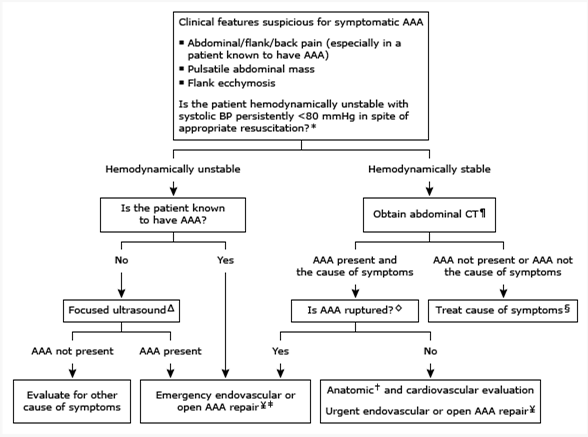The nurse is reviewing the medical electronic record of a client with abdominal aortic aneurysm less than 3 cm in size. Which medical treatment should the nurse anticipate to be prescribed for the client?
Ultrasound every six (6) months.
Intravenous pyelogram yearly.
Assessment of abdominal girth monthly.
Repair of abdominal aortic aneurysm
The Correct Answer is A
Based on the information provided, the nurse should anticipate that the medical treatment prescribed for a client with an abdominal aortic aneurysm less than 3 cm in size would be regular ultrasound screenings every six (6) months.
Monitoring the size of the abdominal aortic aneurysm through ultrasound is a common approach for managing small aneurysms. Regular ultrasound screenings allow healthcare providers to track the growth rate of the aneurysm and determine if any intervention, such as surgical repair, is necessary as the aneurysm progresses in size.
Let's review the other options and explain why they are not the most appropriate treatments for an abdominal aortic aneurysm less than 3 cm in size:
Intravenous pyelogram yearly: An intravenous pyelogram is an imaging test used to evaluate the urinary system, specifically the kidneys, ureters, and bladder. It is not directly related to the management or monitoring of an abdominal aortic aneurysm.
Assessment of abdominal girth monthly: Assessing the abdominal girth may be a part of the overall assessment of the client's condition, but it is not the primary treatment for managing an abdominal aortic aneurysm. Monitoring the aneurysm size through regular ultrasound screenings is a more specific and accurate approach.
Repair of abdominal aortic aneurysm: Repair of an abdominal aortic aneurysm is typically indicated when the aneurysm reaches a certain size threshold or if it poses a high risk of rupture. For an aneurysm less than 3 cm in size, repair is usually not the initial treatment option. Instead, regular monitoring through ultrasound screenings is recommended to assess the aneurysm's growth rate and determine the appropriate time for intervention.

Nursing Test Bank
Naxlex Comprehensive Predictor Exams
Related Questions
Correct Answer is ["A","B","C","D"]
Explanation
The information that the nurse should include in the discharge teaching for the client who is three days post-operative abdominal aortic aneurysm repair is as follows:
Notify the healthcare provider (HCP) of any redness or irritation of the incision: This is important because redness or irritation can be signs of infection or other complications at the surgical site. Prompt reporting allows for early intervention and management.
Do not lift anything more than 20 pounds: Following abdominal aortic aneurysm repair, it is crucial to avoid heavy lifting or straining as it can put excessive pressure on the surgical site and potentially lead to complications such as incisional hernia. Restricting lifting to no more than 20 pounds helps to protect the incision and promote proper healing.
Inform the client that there may be pain not relieved with pain medication: Pain management is an essential aspect of post-operative care. However, it is important for the client to understand that complete relief of pain may not always be achievable with pain medication alone. They should be aware that mild to moderate discomfort may persist during the healing process, but severe or worsening pain should be reported to the healthcare provider.
Stress the importance of having daily bowel movements: After abdominal surgery, it is common for bowel movements to be delayed due to factors such as anesthesia, reduced activity, and pain medication. However, it is crucial for the client to maintain regular bowel movements to prevent constipation and potential complications such as bowel obstruction. The nurse should provide guidance on strategies to promote regular bowel function, such as staying hydrated, eating a balanced diet rich in fiber, and using stool softeners or gentle laxatives as directed by the healthcare provider.
Correct Answer is D
Explanation
Choice D: This question is crucial as it addresses the client's adherence to their prescribed medication regimen for managing high blood pressure. Consistent medication use is essential for controlling blood pressure and reducing the risk of complications associated with hypertension. The elevated blood pressure reading suggests that the current medication regimen may not be effectively controlling the client's blood pressure. By assessing medication adherence, the nurse can determine if non-adherence is contributing to the high blood pressure reading or if adjustments to the medication regimen are required.
"Have you recently taken any antihistamines?": Asking about recent antihistamine use is not directly relevant to the client's high blood pressure reading of 210/106 mm Hg. Antihistamines are medications primarily used to relieve allergy symptoms and do not typically have a significant impact on blood pressure levels.
"Have there been recent stressful events in your life?": While stress can contribute to temporary increases in blood pressure, asking about recent stressful events is not the most critical follow-up question in this situation. The client's blood pressure reading of 210/106 mm Hg indicates a severe elevation that requires immediate attention and management beyond stress reduction alone.
"Did you take any acetaminophen today?": Acetaminophen, also known as paracetamol, is a pain reliever and fever reducer. It does not typically have a significant effect on blood pressure. Therefore, asking about acetaminophen use is not the most relevant follow-up question for the client's high blood pressure reading.
Whether you are a student looking to ace your exams or a practicing nurse seeking to enhance your expertise , our nursing education contents will empower you with the confidence and competence to make a difference in the lives of patients and become a respected leader in the healthcare field.
Visit Naxlex, invest in your future and unlock endless possibilities with our unparalleled nursing education contents today
Report Wrong Answer on the Current Question
Do you disagree with the answer? If yes, what is your expected answer? Explain.
Kindly be descriptive with the issue you are facing.
